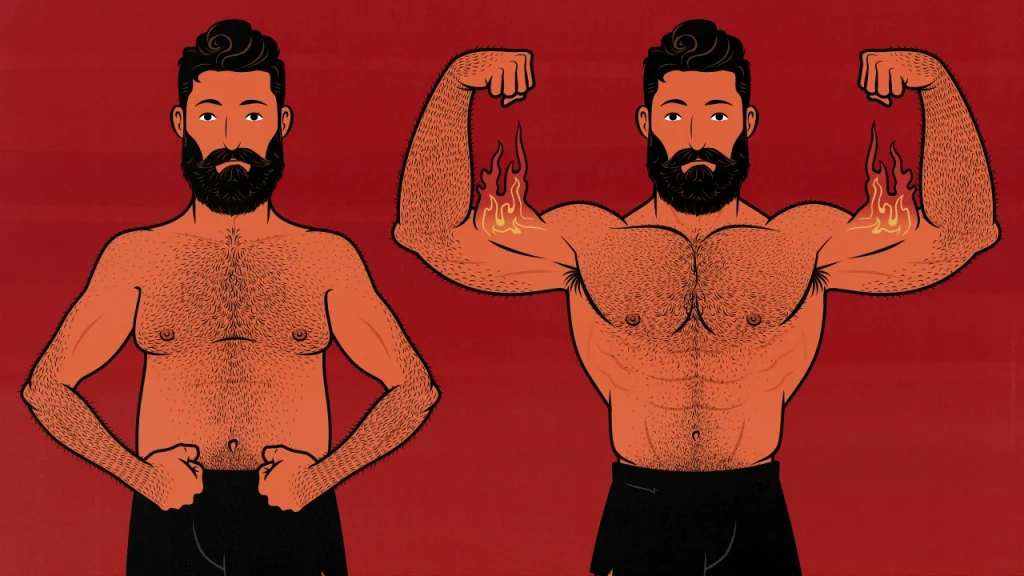
Body Recomposition: How to Build Muscle While Losing Fat
Body recomposition is when you build muscle while losing fat. It sounds like the Holy Grail, but it isn’t quite so rare as that. Recomping is realistic for most people. We’ll show you client transformations and study results.
You can recomp by lifting weights, doing cardio, eating a better diet, or improving your sleep. We’ll delve into each of those methods, including the results you can expect with every change you make. But you can do much better than that.
The shotgun approach is when you do a few different things, hoping at least one of them gives you the results you want. We’ll take a firing squad approach, firing several well-aimed bullets. Each method is strong enough to reliably produce results. Together, they’re truly fearsome.

What is Recomping?
Body recomposition is when you build muscle and lose fat at the same time. But you’ll waste calories saying you’re “trying to achieve body recomposition.” It’s much easier to say you’re “recomping.”
To recomp, you need to stimulate muscle growth while eating a diet that supports muscle growth. The calories you use to build muscle won’t be stored as fat. Under the right circumstances, you can even burn fat to fuel muscle growth. That’s what this article is about.
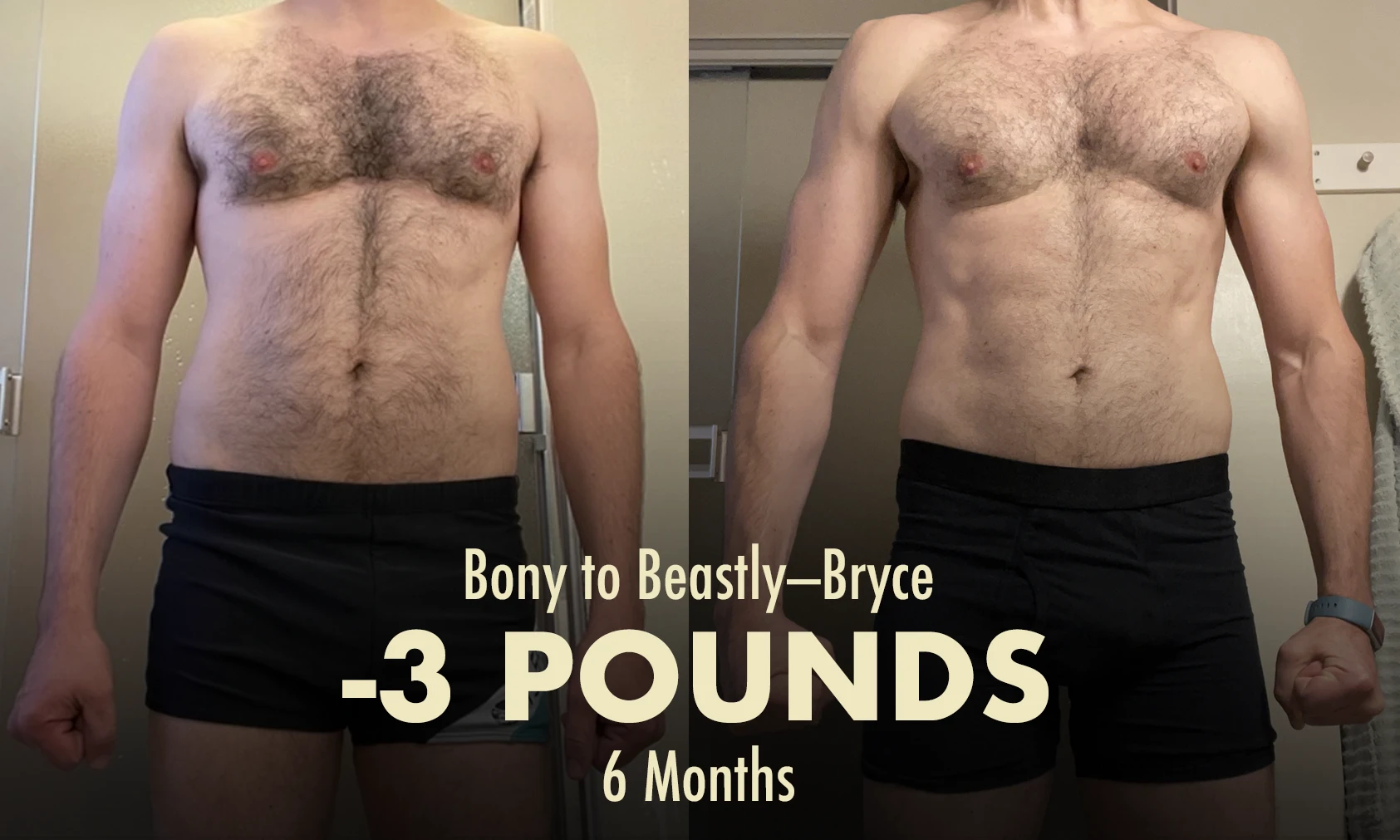
Recomping is fantastic for overweight and skinny-fat people. It’s difficult, but it’s also effective and enjoyable. You won’t feel the desperate pangs of hunger that come with cutting, nor the oppressive fullness of a long bulk. Instead, you can work up an appetite with a rigorous workout routine and then satisfy it with nutritious food.
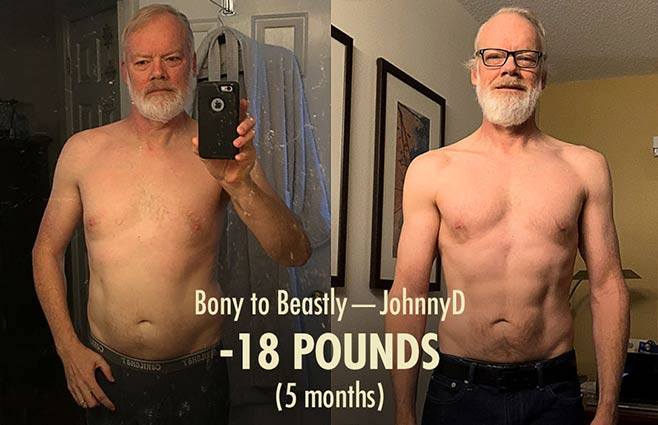
Note: If you’re overweight, you can build muscle while losing weight. That’s a form of body recomposition, but most people call it “cutting.” We have another article about cutting. This article isn’t about weight loss.
Is Body Recomposition Possible?
Body recomposition is completely realistic for most people. Most studies that put people on a workout program (of any kind) find simultaneous muscle growth and fat loss. It’s also pretty common to see body recomposition in nutrition and lifestyle studies. We’ll show you plenty of examples throughout the article, both from clients and studies.
However, recomping doesn’t work for everyone. It’s only for people with an abundance of fat to lose. Skinny and lean people don’t have enough excess fat to fuel a significant amount of muscle growth. They need to get their extra energy from their diets. They need to bulk to build muscle.
How to Build Muscle While Losing Fat
Do Enough Exercise (Easiest)
If you’re overweight and out of shape, you can start by going on walks. We’ll talk about the most effective methods in a moment, but walking makes for a good first step. It’s easy to do, easy to enjoy, and easy to recover from.
Walking isn’t intense enough for people already in good shape, but if you’re just getting started, it should be enough stimulation to provoke some cardiorespiratory adaptations, spark a little muscle growth, and burn some fat. Perhaps more importantly, you’ll begin burning away your visceral fat—the unhealthy type of fat that accumulates around your organs, increasing your waist size (study).
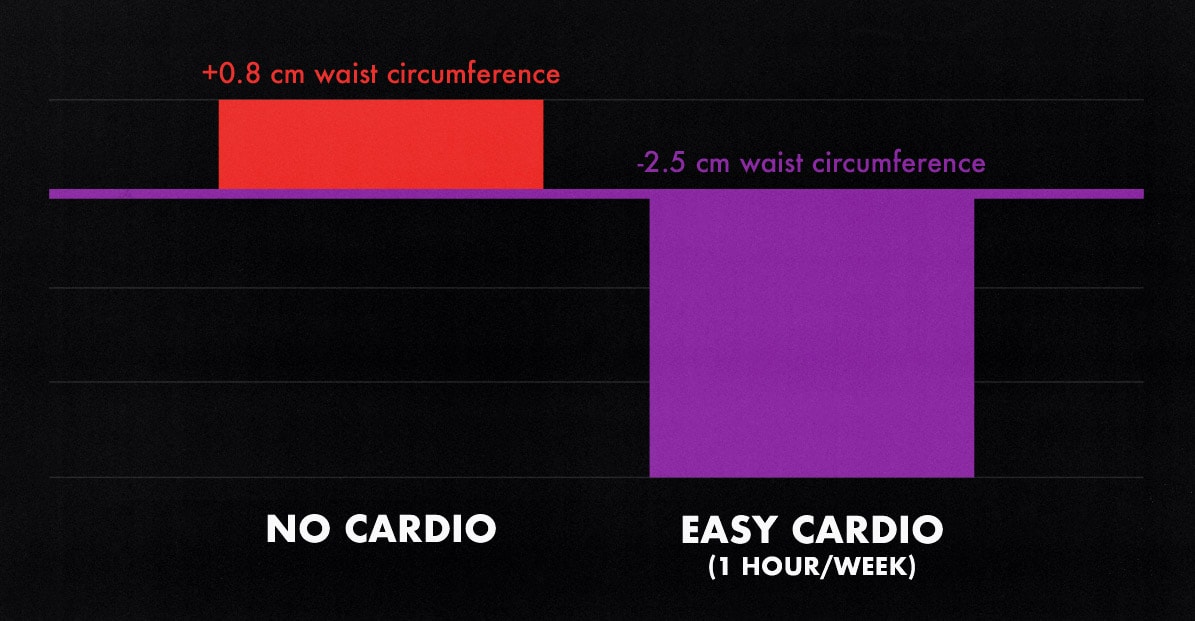
In an 8-week study by Keating and colleagues, the sedentary participants gained fat, whereas the participants who did easy cardio (such as walking) trimmed 2.5cm off their waistlines (study).
I recommend a brisk 25-minute walk every morning, walking at the fastest pace you can manage. That will give you 175+ minutes of cardio per week. That’s enough to meet the minimum cardio requirements for general health (reference).
Hypertrophy Training (Most Important)
Hypertrophy training isn’t very good for losing weight (study). You can burn 200–400 calories per workout, which isn’t nothing, but it pales in comparison to the calories you can burn by doing more cardio.
However, hypertrophy training is by far the most powerful way to provoke body recomposition (study). Lifting makes your body desperate to build muscle. Whether you lose weight or not, your body will invest its energy into growing stronger, replacing the fat you lose with muscle.
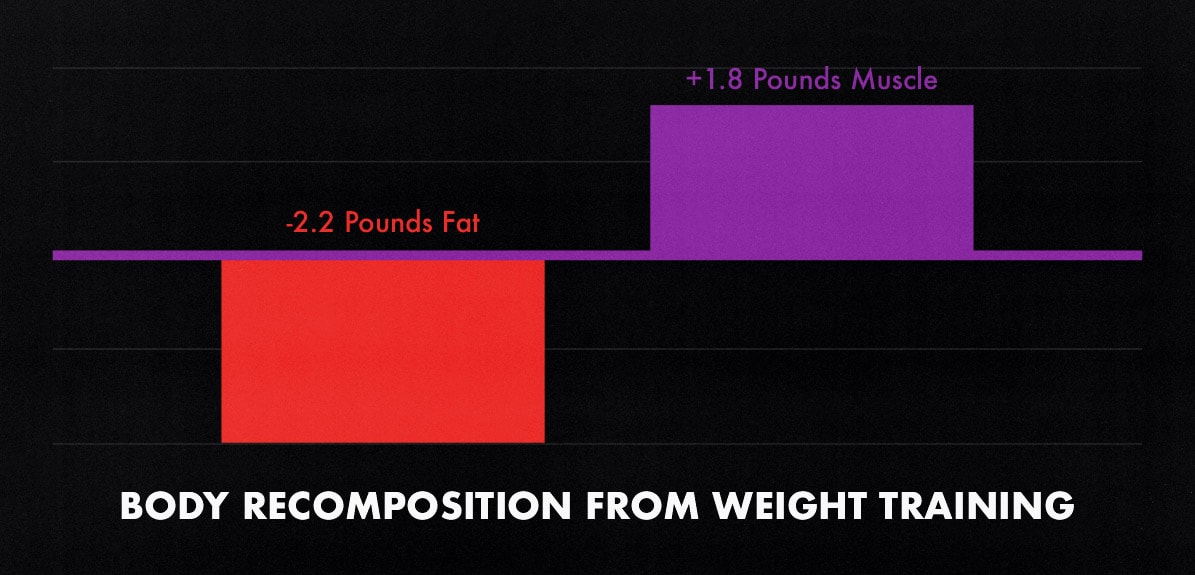
The best data we have comes from a big meta-analysis by Lopez and colleagues (meta-analysis). He pooled the data from 116 studies, finding that ≈15 weeks of weight training caused people to lose ≈2 pounds of fat while gaining ≈2 pounds of muscle. Keep in mind that the participants didn’t change their diets or their lifestyles, and they weren’t doing cardio. You can do much better.
There are different types of hypertrophy training. You can train heavier, lighter, or both. You can use your body weight, dumbbells, barbells, or train at a fully equipped gym. You can even use resistance bands, though they aren’t quite as effective. What matters is that you challenge your muscles—all of your muscles.
Your workout program doesn’t need to be perfect, but it pays to follow a good one. The better your workouts are, the more muscle growth you’ll stimulate, and the more body recomposition you’ll get.
You can maximize your results with 3–4 workouts per week, each lasting 45–90 minutes. 3-day routines tend to work best for beginners. 4-day routines often work slightly better for intermediate lifters.
For more, we have an article on hypertrophy training. That’s a good place to start. If you already know how to lift weights, we have a full intermediate hypertrophy program here.
The Body Recomposition Diet
Eating enough protein is important. For example, in a study by Longland and colleagues, both groups succeeded at losing weight and burning fat, but only those eating enough protein managed to build muscle (study).
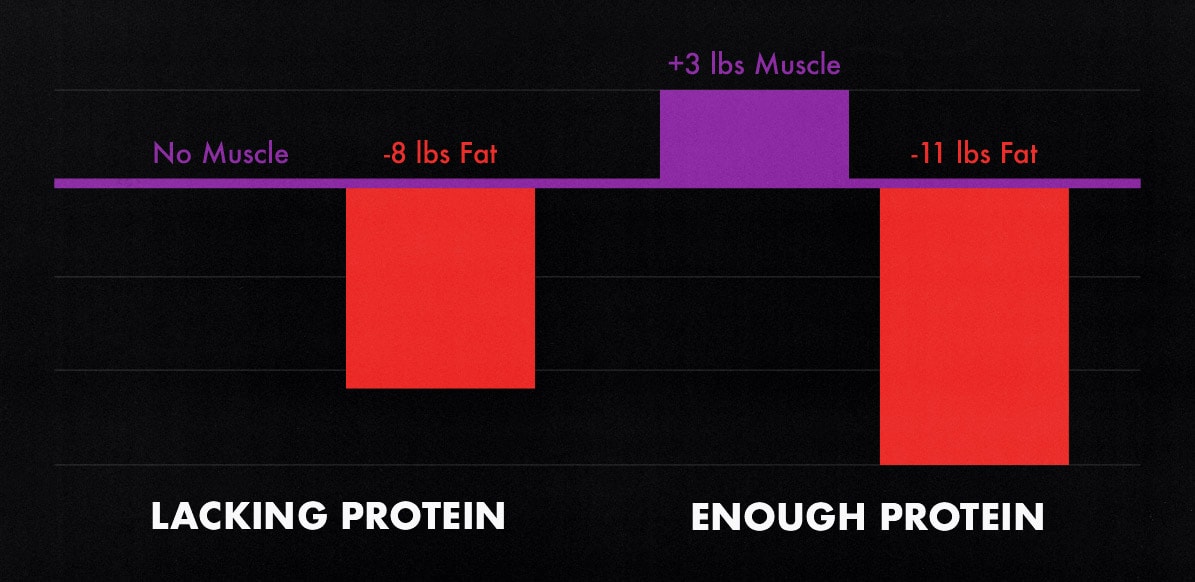
The high-protein group ate 1.1 grams of protein per pound of body weight per day. That’s a fairly high protein intake. You need tons of protein when you’re losing weight that quickly. If you aren’t trying to lose weight, 0.7 grams of protein per pound is enough to maximize your rate of muscle growth (study).
It also helps to eat a good diet overall. Try to eat balanced meals that contain a source of protein, carbs, fat, and fibre. The classic example is chicken breast, whole-grain rice, and broccoli drizzled with olive oil. Many traditional meals are perfect, though:
- Chili con carne (my favourite)
- Baked salmon with potatoes and asparagus
- Greek yogurt with berries
- Oatmeal with milk and peach slices
- Vindaloo stew
- smoothies
- Picadillo
- Stir fry
- Paella
- Sushi.
Our Bony to Beastly Program has a recipe book full of balanced meals. We’ve calculated out all the protein and macros, considered all the vitamins and minerals, and explained what makes each meal so nutritious. But most people already have an intuitive idea of what a balanced meal looks like.
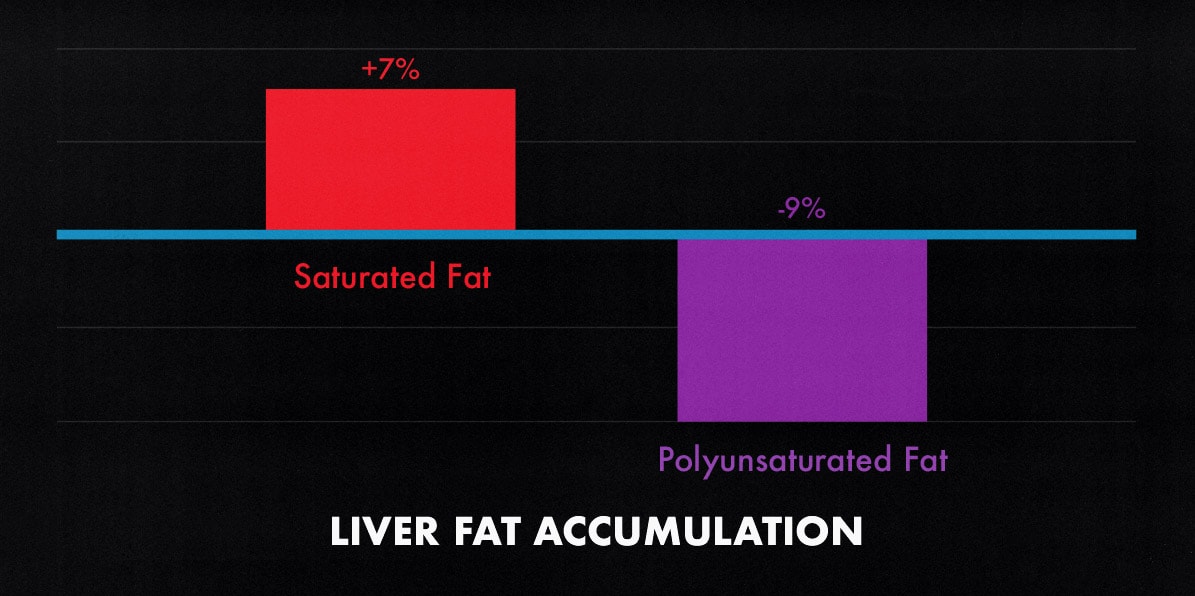
You don’t need to change your entire diet all at once. You can start with simple swaps. For example, in a study by Bjermo and colleagues, the participants were given foods rich in different types of fat. Those who ate foods richer in processed saturated fat (from butter) gained visceral fat, whereas those who ate foods richer in polyunsaturated fat (the type of fat found in nuts) burned it.
Living a Healthy Lifestyle
Improving your bedtime routine is the best place to start. Better sleep will give you more energy to exercise, more motivation to lift weights, and more willpower to eat a better diet. It will also improve your hormone profile, causing body recomposition.
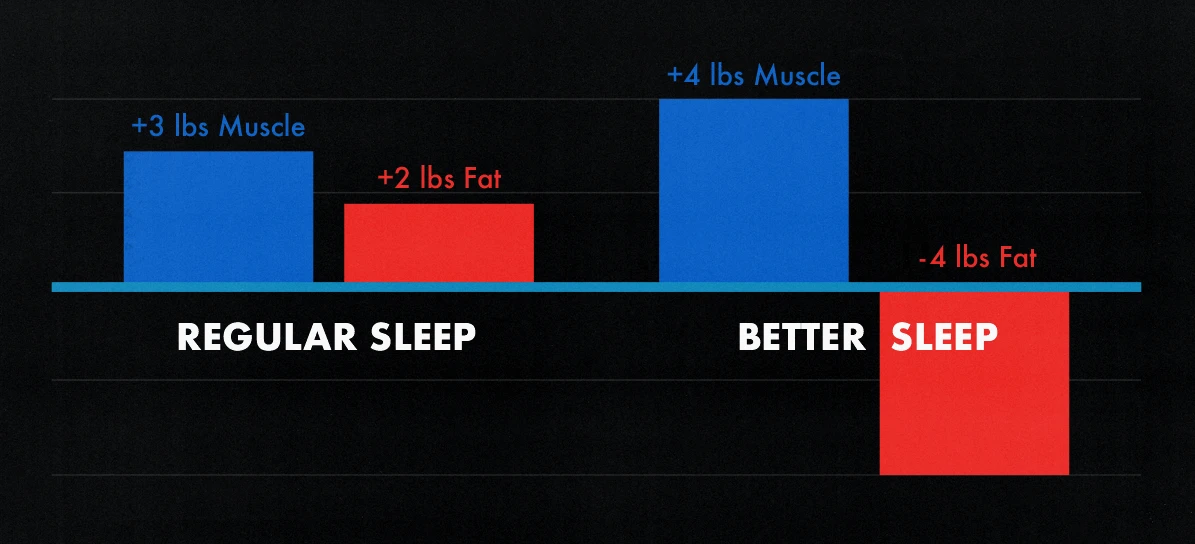
In a study by Jabekk and colleagues, the group who lifted weights got fairly typical bulking results, gaining 60% muscle and 40% fat (study). The other group followed the same workout program, but they were also given some tips about how to improve their sleep. They gained 30% more muscle and lost fat, achieving body recomposition.
The most important thing is to give yourself enough time in bed. Try to get at least 7 hours of sleep every night. Some people benefit from 8 or even 9 hours. If your alarm clock wakes you up in the morning, go to bed a little earlier. Be serious with your bedtime. Try to go to bed at the same time every night (give or take 30 minutes).
We cover the rest of the sleep tips in our article about sleep. If you have trouble falling asleep or if you wake up during the night, that article should help.
A Note on Calories
It’s okay if your weight changes. When you start eating a better diet and doing more exercise, you might find that you slip into a calorie deficit and lose a bit of weight. Or you may find that lifting weights stimulates your appetite, bringing you into a small calorie surplus and causing a bit of weight gain.
I find body recomposition works best when you listen to your appetite. You don’t need to force your weight up or down. You don’t need to micromanage your calories. Focus on doing cardio, lifting weights, eating a nutritious diet, and getting enough sleep.
Still, some people find it helps to count calories. That can certainly work. Here’s a review of our favourite calorie tracker. The article includes a section on how to track calories for body recomposition.
A Note on Progressive Overload
Keep track of your performance in the gym. Write down how much weight you’re lifting and how many reps you’re getting, then strive for progressive overload. Every workout, try to add weight and/or reps. If you’re making progress, you’re doing great. Keep going.
You won’t be able to make progress on every lift every workout, but you should see improvement on most lifts most weeks. If you’re more advanced, aim for progress on most lifts most months.
If you hit a plateau, you can do more exercise, follow a better workout routine, or eat a better diet. But that won’t work forever. At a certain point, your body will hesitate to burn your dwindling fat stores to feed your already strong muscles. When that happens, you’ll be in good shape, and recomping may not be viable anymore.
When you stop making progress, you’ll need to bulk to continue building muscle or cut to continue burning fat. It doesn’t need to be a drastic change. You can cut slowly to keep all the muscle you fought so hard to build. You can bulk leanly so as not to regain all the fat you lost.
Conclusion
Each of the methods we covered is enough to provoke body recomposition, especially if you’re overweight and out of shape. If you combine them all together, the results can be dramatic:
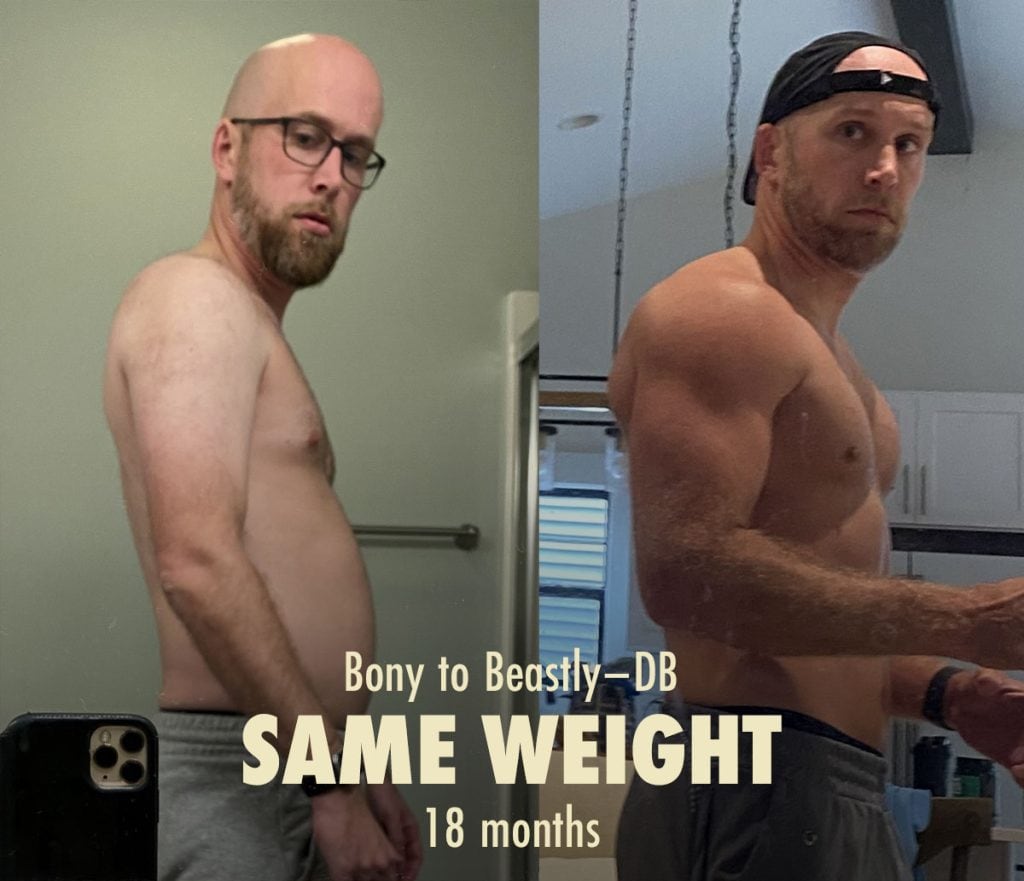
Alright, that’s it for now. If you want more muscle-building and fitness information, we have a free newsletter. If you want a full exercise, diet, and lifestyle program to help you recomp, check out our Bony to Beastly Program. Or, if you’re already an intermediate lifter, check out our customizable Outlift Hypertrophy Program. We made both programs with body recomposition in mind.
Feel free to ask questions below. I’ll answer all of them.

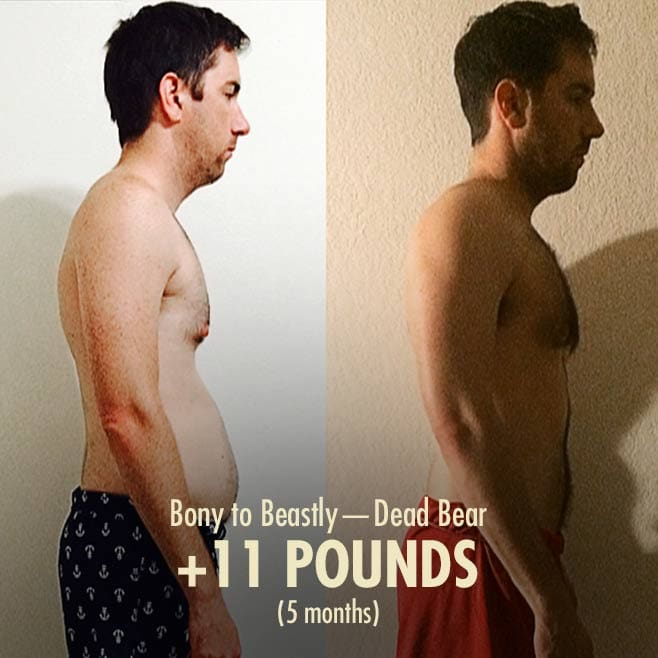


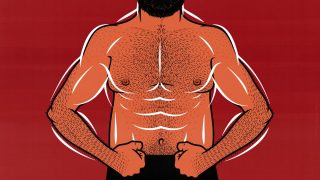

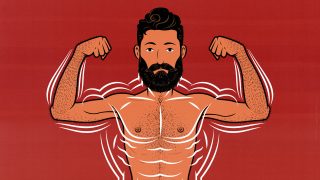
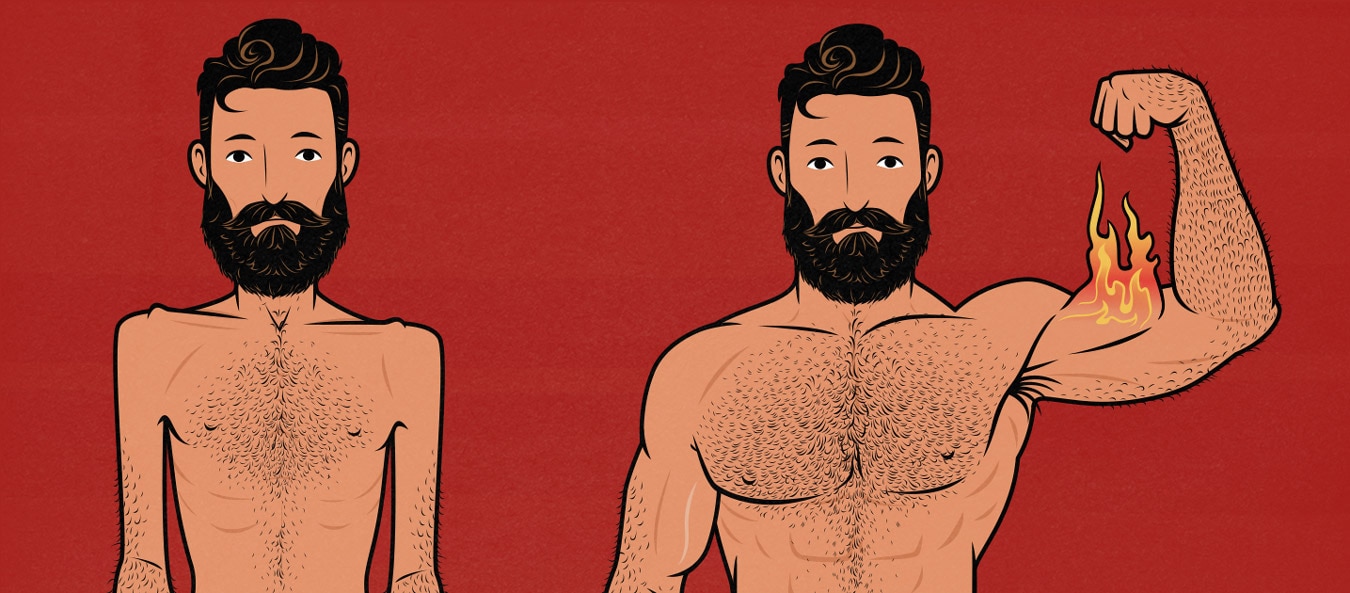
Great and balanced article Shane, thanks man. Recomp also gets tougher for us old guys (65 for me), but the principle is great. And Outlift still works.
Thank you, Peter! Yeah, recomping definitely isn’t for everyone.
That’s an amazing profile picture.
Hi Shane,
Your article is, as always, very informative. I do have a question, though. I find myself at a crossroads: I’m 5’9″ and weigh 157 pounds, with a BMI of 23.2. I sport a visible six-pack under good lighting conditions. While not exactly “big,” I look good in a polo and have received compliments on my physique. However, I estimate my body fat to be around 12%-13%, mainly concentrated on my lower abs and lower back, and it’s driving me crazy.
I feel like I’m in a dilemma. I’m lean, but not nearly enough to be “shredded,” and I’m also not big enough to be consider myself muscular. I’m eager to get rid of the pouch on my lower abs and would gladly sacrifice size to achieve this. However, I don’t want to end up looking gaunt.
After some informal research, it seems like bulking to increase muscle size and then cutting down might be a viable option. I’m assuming the logic behind this is that having enough muscle would support a lower body fat percentage without appearing too skinny. Another option is a recomp. I’d love to hear your thoughts!
Best,
Dan
Thank you, Dan!
It sounds like you’re already in pretty good shape. You don’t have much body fat to spare, so your body will be reluctant to burn it. You might be able to make a bit of progress with body recomposition, but even if you do everything perfectly, you could just easily wind up spinning your wheels.
Cutting wouldn’t make much sense. You’re already at the bottom of the healthy body fat percentage range. If you got shredded, you’d regain the fat as soon as you started eating enough calories to build muscle.
A lean bulk is probably the best path forward. You can build the muscle you want, then cut afterwards.
Getting shredded often means looking gaunt. You can offset that somewhat by bulking up your neck, but you may still lose the fat in your face. It depends on the person. It also depends on exactly how lean you’re trying to get. 10% body fat is quite different from 7%.
Putting it all together, you could try your best to make progress in the gym without intentionally manipulating your calories. See if you can gain strength on your lifts while losing fat. Maybe you can. And then when you hit a plateau, start adding more calories into your diet, supporting more muscle growth.
Hi Shane,
I am amazed at the quantity and quality of information to be found here; very glad your site showed up!
I am an extreme version of Daniel’s case: 55 years old, 5’11” and 150 pounds, avid long distance cyclist from many years.
At this weight and height I should be considered lean, but the issue is that I am extremely skinny in the legs, in the chest and especially in the face (close to corpselike…) with a substantial and stubborn belly localized only around the belly button since I was 30. All the fat calculators give me at 16-18 % body fat, probably as a result of just my belly circumference (I haven’t done a DEXA scan, but various methods seem to converge there). I cannot increase my aerobic routine since it is already very dense. I have never lifted weights before (typical old times cyclist…).
Given my general appearance and especially my face I should bulk up but I am very nervous that I will certainly increase my belly fat and not sure about the rest. I have just started a weight lifting routine since a few weeks. My idea would be ideally to go through some sort of body recomp but I guess it would not be enough.
I am really stuck, I am afraid to try to bulk up.
What would you suggest from your experience with skinny fat guys?
Many thanks and all the best.
Hey Isaac, if you’re an avid long-distance cyclist, you’re probably doing enough overall exercise. That’s one of the best thing you can do to minimize visceral fat, so it’s strange that you’ve got it. Lifting weights sounds like the perfect thing to add into your routine. That’s by far the most powerful way to provoke body recomposition. But let’s see if there’s anything else we ought to focus on.
What’s your diet like? Are you eating a balanced diet most of the time? Enough protein, enough fibre, healthy fats, and lots of nutritious foods?
What’s your sleep like? Are your energy levels good throughout the day?
What’s your waist circumference at the height of your belly button?
There’s no harm in starting with a recomp. You might be able to whittle away at the trunk fat while building some muscle through your limbs. Even if you can’t, the worst case scenario is that you’d get better at lifting weights without noticing much change in your body composition. That isn’t anything to be afraid of. After a few weeks of not making measurable progress, you could add a small amount of calories to build more muscle. You could also remove calories to lose fat, but if most of your body is corpselike, it probably makes sense to build some muscle first.
A lean bulk won’t open the floodgates of fat gain. You won’t wake up one morning with 20 extra pounds of fat. Maybe you’d gain a little bit more fat than you’d like, but it will come slowly, and you can fix it as soon as you notice it. Again, the worst case scenario isn’t anything to fear.
Thank you Shane,
diet and sleep are generally OK and energy levels are not bad; so, I do not see anything critical there, although there might be room for improvements.
Waist circumference is around 34 inches and even if it may not sound huge I am overall so thin that it makes the belly protrude in a very visible way.
Last year I was almost 10 pounds heavier and the waist was around 36 inches. After an intese cycling summer, I lost weight but my performance uphill remained exactly the same, this means I lost power…
I think I will try first to keep training especially in the gym without cutting or bulking and see for a few weeks. If I am not able to build muscles consistently, I will give it a try and bulk up very cautiously.
My pleasure!
Ah, yeah, 34 inches is good. But I can see how having all your fat concentrated there could be frustrating. And perhaps being thin elsewhere makes your waist look proportionally larger. Building muscle should help with that.
Nice job getting it down from 36 inches. That’s a great improvement.
Good luck! I hope you’re able to regain your cycling power, too.
Hello, Shane, great article, I am wondering if it is possible to change the ratio of body fat to muscle in a high weight? I am 188 cm tall and weigh 117 kg and I have a good diet and exercise. Is it possible to do body reconstruction without changing the scale?
Hey Amir, absolutely! When you’ve got an abundance of body fat, your body will be glad to burn it for energy, using that energy to build muscle.
Instead of focusing on losing or gaining weight, focus on getting stronger, eating well, and living a healthy lifestyle, including a nice sleep routine.
This article is so great. I’ve watch too many videos about body recomp and this one is the best one and I understand it well. Im 28 with body fat of 32%, 5″8 in height and 176 lbs in weight. Im very confuse if I will cut or bulk because i dont want fo look thin when cut and I dont want gain body fat as well when I bulk. Thanks man!
Thank you, Bryan!
I would do a recomp where you follow a good hypertrophy training program, eat a nutritious diet (with enough protein), and live a healthy lifestyle. I wouldn’t force your weight up or down. I’d let it go where it wants, at least at first. Weigh yourself every week to see where your weight is trending, but don’t worry about cutting or bulking. Listen to your appetite.
When you start to struggle with progressive overload, having difficulty adding weight or reps to your lifts, then you could think about cutting (to lose more fat) or bulking (to build more muscle). Until then, I think recomping will work well.
Whatever you choose, good luck!